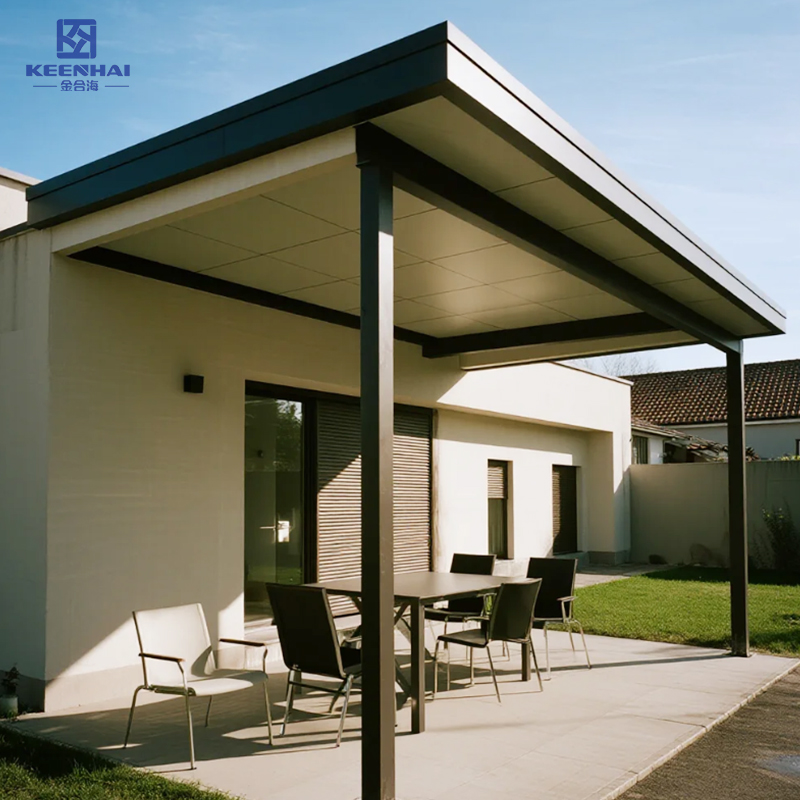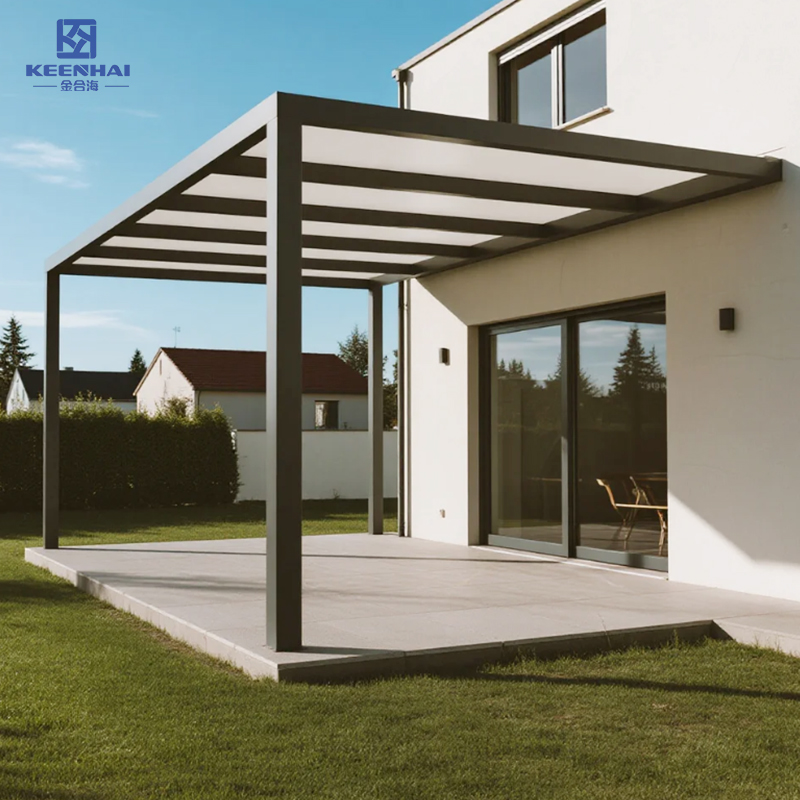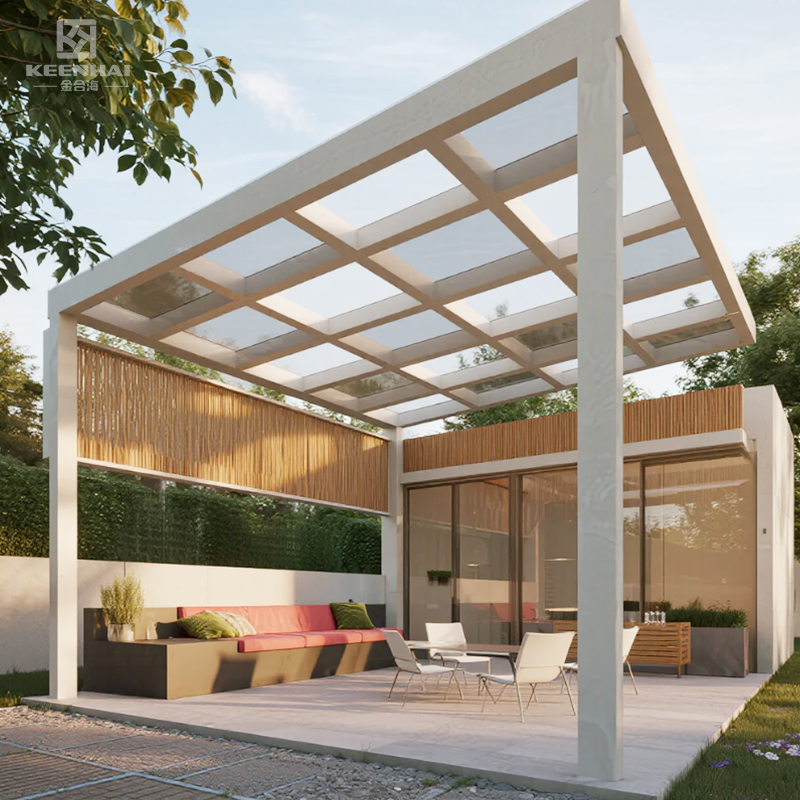
Definition of a Bioclimatic Pergola
A bioclimatic pergola is an advanced outdoor structure designed to optimize comfort by adapting to the surrounding climate. Unlike traditional pergolas, it features an adjustable louvered roof system that controls sunlight, ventilation, and rain protection automatically or manually. This innovation allows users to regulate their outdoor environment precisely, making the space usable throughout various weather conditions. The core technology behind the bioclimatic pergola integrates principles of bioclimatic architecture, which emphasizes energy efficiency and harmony with natural elements.
The term "bioclimatic" refers to the interaction between buildings (or structures) and the local climate to improve comfort and reduce energy consumption. In the context of a pergola, this means the structure can respond dynamically to weather changes, such as adjusting the angle of louvers to maximize shade during hot days or open them to allow sunlight when it's cooler.
If you're considering upgrading your outdoor area, a modern bioclimatic pergola offers not only aesthetic appeal but also functional benefits that traditional pergolas cannot match.
Key Features That Define a Bioclimatic Pergola
Several characteristics set a bioclimatic pergola apart:
-
Adjustable Louvers: The roof consists of multiple aluminum louvers that tilt between 0° and 135°. This precise control over the louver angle allows users to regulate the amount of sunlight or airflow entering the space.
-
Weather Responsiveness: Equipped with sensors, some bioclimatic pergolas can automatically adjust louvers in response to rain, wind, or sunlight intensity, ensuring user comfort and protecting the structure itself.
-
Durable Materials: Most bioclimatic pergolas use high-quality aluminum for the frame and louvers due to its corrosion resistance, strength, and lightweight properties. Aluminum also contributes to long-term durability with minimal maintenance.
-
Integrated Drainage System: The louvers channel rainwater through hidden gutters and downspouts, preventing leaks and pooling, a common problem in traditional pergolas.
-
Energy Efficiency: By controlling sunlight and ventilation, these pergolas can reduce the need for artificial cooling or heating in adjacent indoor spaces, indirectly lowering energy costs.
-
Smart Controls: Many models include remote control or smartphone app integration, allowing for convenient and precise adjustments from anywhere.
These features work together to provide a comfortable, adaptable outdoor living area, reflecting the cutting-edge of pergola design.
Differences Between Bioclimatic Pergolas and Traditional Pergolas
| Feature | Bioclimatic Pergola | Traditional Pergola |
|---|---|---|
| Roof Type | Adjustable louvered roof with angle control | Fixed slats or open beams |
| Weather Adaptability | Automatic/manual adjustment for sun, rain, and wind | No weather control; exposes to elements |
| Material | Mostly aluminum with corrosion resistance | Often wood or metal without advanced coatings |
| Drainage | Integrated gutter system for water management | No built-in drainage; water may pool |
| Energy Efficiency | Helps reduce indoor energy usage through natural climate control | Minimal or no impact on energy consumption |
| Automation & Smart Features | Available in many models with sensors and remote control | No automation or smart features |
Choosing a high-quality aluminum prefab pergola from a trusted brand like Keenhai offers the combined benefits of durable materials and smart functionality, ensuring your outdoor space remains comfortable and stylish through all seasons.

How Bioclimatic Pergolas Work
A bioclimatic pergola operates through a combination of smart design and mechanical innovation, allowing it to adapt to changing weather conditions seamlessly. At the heart of its functionality lies an adjustable louvered roof system that enables precise control over sunlight, airflow, and protection from rain. This dynamic system transforms outdoor spaces into comfortable, versatile environments no matter the season.
The design principles borrow heavily from bioclimatic architecture, which optimizes natural elements to create energy-efficient living spaces. Unlike fixed pergolas, a bioclimatic pergola uses mechanical movement combined with sensor technology to respond immediately to environmental changes, ensuring the outdoor area remains usable and enjoyable.
Adjustable Louvered Roof Mechanism
The key feature driving the operation of a bioclimatic pergola is its adjustable louvered roof. This system consists of multiple parallel aluminum slats or louvers, each capable of tilting independently within a range—typically from 0° fully closed to around 135° fully open. This range allows users to control the degree of openness depending on their needs.
-
When fully closed, the louvers create a watertight roof, directing rainwater into an integrated gutter system that prevents leaks and pools. This feature transforms the pergola into a sheltered outdoor room during wet weather.
-
When partially open, the louvers allow filtered sunlight to enter while providing shade and reducing heat buildup. This controlled sunlight exposure maintains comfort while preventing harsh glare.
-
When fully open, the louvers offer full ventilation and exposure to sunlight, ideal for pleasant weather conditions.
Modern bioclimatic pergolas often come with motorized louver controls that can be operated via remote control or smartphone apps. Some models include automatic sensors that adjust the louvers based on real-time weather data, such as sunlight intensity, rain detection, and wind speed, providing hands-free comfort management.
The use of lightweight yet strong aluminum ensures that the louvered roof mechanism operates smoothly and reliably over time. Its corrosion resistance also guarantees longevity in diverse climates, making it an excellent choice for outdoor structures.
Climate Control Through Natural Ventilation and Sunlight Regulation
One of the most impressive aspects of a bioclimatic pergola lies in its ability to create a naturally comfortable microclimate without relying on electrical heating or cooling systems. The adjustable louvers regulate two critical environmental factors: ventilation and sunlight.
-
Natural Ventilation
By adjusting the angle of the louvers, the pergola can control airflow, enabling cool breezes to pass through during hot weather. This ventilation effect reduces heat accumulation under the pergola, lowering the perceived temperature and improving comfort. Controlled airflow also helps prevent stagnant air, reducing humidity and the risk of mold or mildew. -
Sunlight Regulation
Sunlight intensity can vary dramatically throughout the day and across seasons. The pergola’s louvers allow users to optimize sunlight exposure by opening them to capture warmth during cool days or closing them partially to block direct sunlight and UV rays when temperatures rise. This flexibility reduces reliance on artificial shading like umbrellas or curtains and creates a pleasant ambiance tailored to personal preferences.
The dynamic climate control offered by bioclimatic pergolas often results in measurable energy savings for the adjacent indoor spaces. By shading windows and walls strategically, these pergolas lower indoor cooling demands by up to 25%, according to several architectural studies. This makes them not only comfortable outdoor solutions but also contributors to a more sustainable lifestyle.
Using a high-quality Aluminum Prefab Pergola with smart climate control features delivers superior adaptability and comfort, matching modern homeowners’ demand for efficiency and style.

Materials and Construction of Bioclimatic Pergolas
When it comes to building a bioclimatic pergola, the choice of materials plays a huge role in how well it performs and lasts over time. These structures are designed to be outdoors all year round, so the materials need to withstand sun, rain, wind, and temperature changes without losing their functionality or looking worn out.
Manufacturers usually focus on materials that combine strength, light weight, and resistance to corrosion and decay. The construction method also affects how the pergola handles weather and daily use, so both materials and build quality must be top-notch.
Common Materials Used (Aluminum, Wood, etc.)
-
Aluminum
Aluminum is the most popular material for bioclimatic pergolas today. Its natural resistance to rust and corrosion makes it ideal for outdoor use, especially in humid or coastal areas. Plus, aluminum is lightweight, which means the adjustable louvered roof mechanism can operate smoothly without extra strain.
Manufacturers often coat aluminum with powder finishes that add an extra layer of protection against scratches and fading. This helps keep the pergola looking fresh for many years. Another big plus is that aluminum can be easily shaped and fabricated, which allows for sleek, modern designs that fit different styles.
-
Wood
Wood has a classic appeal and gives a warm, natural look. Some bioclimatic pergolas incorporate wooden elements, mainly for the frame or decorative parts. However, wood needs to be specially treated or sealed to resist moisture, insects, and UV damage. Without proper maintenance, wooden pergolas can warp, crack, or rot over time. -
Composite Materials
Some manufacturers combine wood fibers with plastics to create composite materials. These aim to provide wood’s aesthetics with better durability and less upkeep. Composites resist moisture and insects better than natural wood but still may require occasional cleaning and care. -
Steel
Steel frames can add extra strength, especially for larger pergolas. However, steel must be galvanized or powder-coated to prevent rust, and it’s heavier than aluminum, which may affect the ease of louver movement.
Choosing the right material depends on your climate, design preferences, and how much maintenance you want to commit to. For example, an Aluminum Prefab Pergola combines the benefits of durability and low maintenance, making it a favorite for many homeowners.
Durability and Weather Resistance
Bioclimatic pergolas face constant exposure to outdoor elements, so durability is a top priority. Here’s how the common materials stack up:
-
Aluminum stands out for its long lifespan of 15 to 25 years or more when properly coated. It handles rain, sun, and wind without rusting or deteriorating, making it a smart investment for longevity.
-
Wood, even when treated, usually needs refinishing every few years. Without regular care, it may last 5 to 10 years before showing signs of wear like cracks or mold.
-
Composite materials can last 10 to 15 years but vary depending on the quality and exposure conditions.
-
Steel is extremely strong but prone to rust if coatings get damaged, requiring occasional maintenance.
The construction quality also influences durability. Well-engineered pergolas feature sealed joints, reinforced frames, and effective drainage systems to prevent water damage. For example, the louvered roof includes integrated gutters that channel rainwater away, reducing corrosion risk and protecting outdoor furniture beneath.
In areas with strong winds or heavy snow, the structure’s load-bearing capacity is critical. High-quality bioclimatic pergolas often undergo testing to withstand wind speeds up to 120 km/h (75 mph) and snow loads exceeding 100 kg/m². This makes them reliable even in challenging weather.
In summary, selecting the right materials and ensuring solid construction delivers a bioclimatic pergola that not only looks great but also stands up to nature’s tests year after year.

Functional Benefits of a Bioclimatic Pergola
A bioclimatic pergola isn’t just an eye-catching addition to your outdoor space—it offers a range of practical benefits that improve comfort and usability throughout the year. Its design lets you control your environment better than traditional structures, making it a smart investment for any homeowner who values both style and function.
Temperature and Light Adjustment
One of the main advantages of a bioclimatic pergola lies in how it manages sunlight and heat. Thanks to its adjustable louvered roof, you can easily control how much sun enters your space. On hot days, tilting the louvers to block direct sunlight reduces heat buildup, keeping the area cooler without sacrificing fresh air. When the weather turns cooler or you want to soak up some sunshine, simply open the louvers to allow more light and warmth inside.
This ability to fine-tune sunlight exposure means you can create a comfortable outdoor environment regardless of the season. Studies show that such shading systems can reduce surface temperatures by up to 30%, making outdoor living areas more enjoyable and usable for longer periods during the year.
The natural ventilation promoted by the louver system also helps prevent heat stagnation, circulating air smoothly and reducing the need for fans or other cooling devices.
Protection Against Rain and Harsh Weather
Unlike open pergolas, the bioclimatic version offers robust protection from the elements. When rain approaches, closing the louvers forms a waterproof roof that channels rainwater through integrated gutters and downspouts, preventing leaks and pooling beneath. This feature transforms your outdoor area into a dry, sheltered space, letting you enjoy fresh air without worrying about getting soaked.
The pergola also shields against harsh sunlight, wind, and even falling debris. Its sturdy construction, often made with corrosion-resistant aluminum, withstands strong winds up to speeds of 120 km/h in tested models. Some systems include wind sensors that automatically adjust louvers to safer positions during storms, protecting both the structure and your comfort.
This all-weather adaptability means you get more use out of your outdoor space, whether it’s a light drizzle or a blazing summer afternoon.
Energy Efficiency Advantages
Beyond immediate comfort, bioclimatic pergolas contribute to energy savings inside your home. By regulating sunlight before it reaches your windows or walls, the pergola reduces solar heat gain, lowering indoor temperatures naturally. This can cut air conditioning costs by as much as 15-25%, depending on your climate and home orientation.
In cooler months, adjusting the louvers to let in sunlight helps warm adjacent rooms, reducing heating needs. This passive climate control aligns with sustainable living goals and lowers your carbon footprint.
Integrating a high-quality Aluminum Prefab Pergola with these functional benefits creates a versatile, eco-friendly outdoor solution that enhances your property’s value and comfort simultaneously.
While aluminum is widely favored for its light weight and excellent corrosion resistance in structures like bioclimatic pergolas, premium stainless steel materials also play a crucial role in certain outdoor architectural applications where extra strength and durability are necessary. For those interested in exploring high-quality corrosion-resistant metal components, this stainless steel products website offers a comprehensive range designed specifically for outdoor and industrial use. Incorporating stainless steel elements can complement aluminum frameworks, enhancing the longevity and stability of outdoor constructions.
